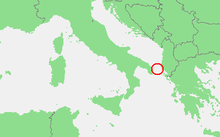Otranto Barrage

The Otranto Barrage was an Allied naval blockade of the Otranto Straits between Brindisi in Italy and Corfu on the Greek side of the Adriatic Sea in the First World War. The blockade was intended to prevent the Austro-Hungarian Navy from escaping into the Mediterranean and threatening Allied operations there. The blockade was effective in preventing surface ships from escaping the Adriatic, but it had little or no effect on the submarines based at Cattaro.
Blockade attempt[]

The Adriatic is 72 km (39 nmi; 45 mi) wide at the Otranto Straits.[1] The blockade consisted mainly of a fleet of drifters, most of them British, and usually armed with a 6-pounder gun and depth charges.[2] In 1915 when the blockade was begun, two divisions of 20 would be on patrol at a time, equipped with steel indicator nets intended to trap submarines or at least alert the surface vessels to their presence. A third division would be at Brindisi.[3] The drifters were supported by destroyers and aircraft. However, the demands of the Gallipoli Campaign and other naval operations left the Otranto Barrage with insufficient resources to deter the U-boats, and only the Austro-Hungarian U-6[4] was caught by the indicator nets during the course of the war. It was later considered that the straits had simply been too wide to be netted, mined or patrolled effectively.[2]
The ease with which German and Austrian submarines continued out of the Austro-Hungarian ports in spite of the barrage (and the success they had in disrupting shipping in the whole of the Mediterranean) strongly embarrassed the Allies, the system being called "a large sieve through which U-boats could pass with impunity".[2] In 1917–1918, reinforcements from the Australian and American navies brought the blockading force up to 35 destroyers, 52 drifters and more than 100 other vessels.[citation needed] Nevertheless, submarines continued to slip through until the end of the war; the introduction of the convoy system and better coordination amongst the Allies only helped to cut the losses they were causing.[2]
Raids and battles[]

The Austrians mounted nighttime raids against the barrage, five in 1915, nine in 1916 and ten in 1917. After a raid by four Huszár-class destroyers in December 1916, a conference in London concluded that the drifters were insufficiently defended. The barrage was placed under the command of a single British officer, Commodore Algernon Walker-Heneage-Vivian, who was able to call upon all Allied ships not in use elsewhere.[3] The largest raid was carried out on the night of 14/15 May 1917 by the cruisers SMS Novara, Helgoland, and Saida supported by the destroyers SMS Csepel and Balaton and Austro-Hungarian U-boats U-4 and U-27, along with German U-boat UC-25 (operating as Austro-Hungarian U-boat U-89). The fleet, commanded by Commodore Miklós Horthy, sank 14 drifters out of 47 on duty, and damaged a further three seriously.[2]
Skipper Joseph Watt was later awarded the Victoria Cross for defending his drifter Gowanlea under heavy attack from Novara. The British light cruisers HMS Dartmouth and Bristol—together with Italian and French destroyers, under command of Italian Rear Admiral Alfredo Acton—steamed from Brindisi to engage the Austrians, resulting in the Battle of the Otranto Straits. The British damaged Saida and disabled Novara, severely injuring Horthy. However, the British cruisers broke off the engagement when the Italian flag officer received notice of heavy Austrian forces coming out of Cattaro. Saida towed Novara back to port. Dartmouth was damaged by UC-25 as it returned to Brindisi. The night before, the same U-boat had laid a minefield at the mouth of Brindisi harbour; the French destroyer Boutefeu struck one of these mines exiting the harbour the very same day and exploded, sinking with all hands.
In June 1918, Horthy—by now commander-in-chief of the Austro-Hungarian Navy—decided to launch an attack on the barrage employing the four Tegetthoff-class battleships based at Pola, the most modern in the fleet. While en route down the Adriatic, the battleship SMS Szent István was torpedoed and sunk by an Italian torpedo boat at dawn on 10 June, resulting in the attack being cancelled.
Notes[]
- ^ Frank K. McKinney (2007). The Northern Adriatic Ecosystem: Deep Time in a Shallow Sea. Columbia University Press. p. 29. ISBN 978-0-231-13242-8. Retrieved 6 March 2013.
- ^ Jump up to: a b c d e First World War – Willmott, H. P., Dorling Kindersley, 2003, Page 186–187
- ^ Jump up to: a b "The Otranto Barrage". Society of Twentieth Century Wargamers Journal. russellphillipsbooks. Retrieved 15 July 2013.
- ^ Otranto Barrage article from firstworldwar.com
References[]
- Millholland, Ray, "The Splinter Fleet of Otranto Barrage" The Readers League of America, New York, NY, 1936
Further reading[]
- Halpern, Paul, The Battle of the Otranto Straits: Controlling the Gateway to the Adriatic in World War I. Bloomington, IN: Indiana University Press, 2004. ISBN 0-253-34379-8. A comprehensive account of the battle.
- (IT) Carlo Stasi, Otranto e l'Inghilterra (episodi bellici in Puglia e nel Salento), in "Note di Storia e Cultura Salentina", anno XV, (Argo, Lecce 2003)
- (IT) Carlo Stasi, Otranto nel Mondo. Dal "Castello" di Walpole al "Barone" di Voltaire (Editrice Salentina, Galatina 2018) ISBN 978-88-31964-06-7
External links[]
| Wikimedia Commons has media related to Otranto Barrage. |
- Mediterranean naval operations of World War I
- Naval battles of World War I involving the United Kingdom
- Naval battles of World War I involving France
- Naval battles of World War I involving Italy
- Naval battles of World War I involving Austria-Hungary
- Naval battles of World War I involving the United States
- History of the Adriatic Sea
